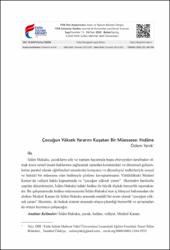| dc.contributor.author | Yanık, Özlem | |
| dc.date.accessioned | 2020-06-26T14:12:02Z | |
| dc.date.available | 2020-06-26T14:12:02Z | |
| dc.date.issued | 6-2020 | en_US |
| dc.identifier.citation | YANIK, Özlem. "Çocuğun Yüksek Yararını Kuşatan Bir Müessese: Hıdâne." FSM İlmî Araştırmalar İnsan ve Toplum Bilimleri Dergisi, FSM İlmî Araştırmalar İnsan ve Toplum Bilimleri Dergisi, 15 (2020): 365-400. | en_US |
| dc.identifier.uri | https://dergipark.org.tr/tr/pub/fsmia/issue/55240/758094 | |
| dc.identifier.uri | https://hdl.handle.net/11352/3082 | |
| dc.description.abstract | İslâm Hukuku, çocukların aile ve toplum hayatında başta ebeveynleri tarafından olmak
üzere temel insanî haklarının sağlanarak zarardan korunmaları ve dönemsel gelişimlerine
paralel olarak eğitilmeleri meselesini koruyucu ve düzenleyici tedbirleriyle sosyal
ve hukukî bir müessese olan hıdâneyle çözüme kavuşturmuştur. Yürüklükteki Medenî
Kanun’da velâyet hakkı kapsamında ve “çocuğun yüksek yararı” ilkesinden hareketle
yapılan düzenlemeler, İslâm Hukuku’ndaki hıdâne ile büyük ölçüde benzerlik taşımaktadır.
Bu çalışmamızda hıdâne müessesesini İslâm Hukuku’nun iç bünyesi bakımından ele
alırken Medenî Kanun ile İslâm Hukuku arasında muâdil bir norm olarak “çocuğun yüksek
yararı” ilkesinin, iki hukuk sistemi arasında ortaya çıkardığı benzerlik ve ayrışmaları
da ortaya koymaya çalışacağız. | en_US |
| dc.description.abstract | In the family and community life Islamic Law resolved the issue of educating children
in parallel with their development by protecting them from harm and by protecting
them from their social and legal institutions. The regulations in the current Civil Law within
the scope of the right to guardianship and based on the principle of “the best interests
of the child” are largely similar to the hidanah in Islamic Law. İn this study, we will try
to reveal the similarity and divergence between the two legal systems that the principle
of “the best interests of the child” as a counterpart norm between the Civil Code and islamic
Law while dealing with the Hidanah Institutions in terms of the internal structure
of Islamic Law. | en_US |
| dc.language.iso | tur | en_US |
| dc.publisher | FSM Vakıf Üniversitesi | en_US |
| dc.rights | info:eu-repo/semantics/openAccess | en_US |
| dc.subject | İslâm Hukuku | en_US |
| dc.subject | Çocuk | en_US |
| dc.subject | Hıdâne | en_US |
| dc.subject | Velâyet | en_US |
| dc.subject | Medenî Kanun | en_US |
| dc.subject | Islamic Law | en_US |
| dc.subject | Child | en_US |
| dc.subject | Hidanah | en_US |
| dc.subject | Custody | en_US |
| dc.subject | Civil Law | en_US |
| dc.title | Çocuğun Yüksek Yararını Kuşatan Bir Müessese: Hıdâne | en_US |
| dc.title.alternative | An Establishment Encompassing the Best Interests of the Child: Hidanah | en_US |
| dc.type | article | en_US |
| dc.contributor.department | FSM Vakıf Üniversitesi, FSM İlmî Araştırmalar İnsan ve Toplum Bilimleri Dergisi | en_US |
| dc.relation.publicationcategory | Makale - Ulusal Hakemli Dergi - Kurum Öğretim Elemanı | en_US |



















